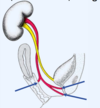Development of Urinary System Flashcards
(39 cards)
What is the embryonic origin of the kidneys?
Intermediate mesoderm

What is the first part of the kidney to develop and in which region?
The pronephros Cervical region
What is in a nephrotome?
Glomerulus, Bowman’s capsule, proximal and distal convoluted tubule, collecting duct

What is the importance of the pronephros?
Produces a pronephric DUCT which extends from the cervical region to the cloaca Drives development of the next developmental stage
What is the cloaca?
Common chamber for the hindgut and urinary systems. Anterior - forms the urogenital sinus Posterior - forms the anus
What are the three key things that develop in urinary embryology?
Pronephros Mesonephros Metanephros

What happens during regression of the pronephric system?
Mesonephric tubules develop which will later form the Bowman’s capsule Capillaries develop which later form the glomerulus
What makes up a renal corpuscle?
Glomerulus and Bowman’s capsule
What is the urogenital ridge?
Area of intermediate mesoderm which gives rise to embryonic kidney and the gonad.

What induces the development of the definitive kidney?
The ureteric bud which sprouts from the mesonephric duct

What does the mesonephros do during development?
Performs renal function in the embryonic kidney
How does the collecting system develop?
Ureteric bud makes contact with the metanephric tissue so that it expands and branches to form the renal pelvis - splits into major and minor calyces

Where are the collecting system and excretory components derived from?
Collecting system - ureteric bud Excretory component - intermediate mesoderm under influence of ureteric bud
Where does the metanephric kidney appear?
In the caudal region
Describe the ascent of the metanephric kidney
In the pelvis, metanephros receives arterial supply from a pelvic branch of the aorta During its ascent, it is vascularised by arteries that come from the aorta at continuously higher levels. Lower vessels usually degenerate.

How does renal agenesis occur?
When the ureteric bud fails to interact with the intermediate mesoderm. Get failure of the kidney to form on that side.
What can abnormal location of the kidneys be caused by?
One of the kidneys fails to pass through the arterial fork formed by the umbilical arteries Kidneys stay in the pelvis close to commn iliac artery - pelvic kidney
How can horseshoe kidneys occur?
Pushed close together during passage through ascent so that the lower poles fuse. Stays at level of lumbar vertebrae since ascent prevented by inferior mesenteric artery.
What is Wilm’s tumour?
Cancer of kidneys Affects children by age 5 Due to a mutation Can be associated with other mortalities
What are duplication defects and ectopic ureteral orifices caused by?
Partial/complete splitting of the ureteric bud can cause ectopic ureteral opening/two ureters.
Where can ureters drain into in ectopic ureteral orifices?
Vagina, urethra, abnormal entrance in bladder, epididymal region

What causes cystic kidney disease?
Atresia of the ureter Urine cannot get to the bladder Large, fluid-filled cysts form in the kidney
What mode of inheritance is polycystic kidney disease?
Autosomal recessive
What happens in polycystic kidney disease?
Cysts form from collecting ducts so kidneys become large Renal failure occurs Presents early with a poor prognosis








